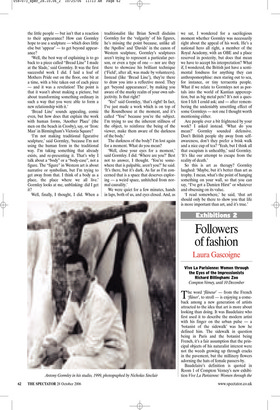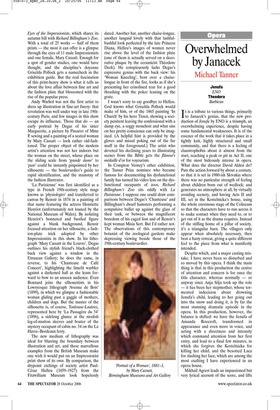Followers of fashion
Laura Gascoigne
Vive La Parisienne: Women through the Eyes of the Impressionists Richard Billingham: Zoo Compton Verney, until 10 December
The word ‘flâneur’ — from the French ‘flâner’, to stroll — is enjoying a comeback among a new generation of artists attracted to the idea that art is more about looking than doing. It was Baudelaire who first used it to describe the modern artist with his finger on the urban pulse — a ‘botanist of the sidewalk’ was how he defined him. The sidewalk in question being in Paris and the botanist being French, it’s a fair assumption that the principal objects of his naturalist interest were not the weeds growing up through cracks in the pavement, but the millinery flowers adorning the hats of female passers-by.
Baudelaire’s definition is quoted in Room 1 of Compton Verney’s new exhibition Vive La Parisienne: Women through the Eyes of the Impressionists, which shares its autumn bill with Richard Billingham’s Zoo. With a total of 25 works — half of them prints — the most it can offer is a glimpse through the eyes of 11 male Impressionists and one female, Mary Cassatt. Enough for a spot of gender studies, one would have thought, and the discipline’s doyenne Griselda Pollock gets a namecheck in the exhibition guide. But the real fascination of this print-heavy show is what it tells us about the love affair between fine art and the fashion plate that blossomed with the rise of the popular press.
Andy Warhol was not the first artist to dress up illustration in fine-art finery: that revolution was well under way in late 19thcentury Paris, and few images in this show escape its influence. Those that do — an early portrait by Degas of his sister Marguerite, a picture by Pissarro of Mme P. sewing and a painting of a seated woman by Mary Cassatt — look rather old-fashioned. The proper object of the modern artist’s attention was not her indoors but the woman on the street, whose place on the sliding scale from ‘grande dame’ to ‘pute’ could be instantly pinpointed by her silhouette — the boulevardier’s guide to rapid identification, and the mainstay of the fashion illustrator.
‘La Parisienne’ was first identified as a type in French 19th-century style mags known as ‘physiologies’ and transferred to canvas by Renoir in 1874 in a painting of that name featuring the actress Henriette Henriot (unfortunately not loaned by the National Museum of Wales). By isolating Henriot’s bonneted and bustled figure against a blank background, Renoir focused attention on her silhouette, a fashion-plate trick adopted by other Impressionists in this show. In his lithograph ‘Mary Cassatt in the Louvre’, Degas outlines his stylish friend’s black-clothed back view against a window in the Etruscan Gallery; he does the same, in reverse, to his ‘Chanteuse de Café Concert’, highlighting the limelit warbler against a darkened hall as she leans forward to bow to an unseen audience. Even Bonnard joins the silhouettists in his Lowryesque lithograph ‘Avenue de Bois’ (1899), in which we glimpse a fashionable woman gliding past a gaggle of mothers, children and dogs. But the master of the silhouette is, of course, Toulouse-Lautrec, represented here by ‘La Passagère du 54’ (1896), a sidelong glance at the modish leg-of-mutton sleeves and boater of the mystery occupant of cabin no. 54 on the Le Havre–Bordeaux ferry.
The new medium of lithography was ideal for blurring the boundary between illustration and art, and these marvellous examples from the British Museum make one wish it would put on an Impressionist print show of its own. By comparison, the drypoint etchings of society artist PaulCésar Helleu (1859–1927) from the Fitzwilliam Museum look hopelessly dated. Another hat, another chaise-longue, another languid lovely with that lashfulbashful look perfected by the late Princess Diana, Helleu’s images of women never rise above the level of the fashion plate (one of them is actually served on a decorative plaque by the ceramicist Théodore Deck). He conspicuously lacks Degas’s expressive genius with the back view: his ‘Woman Kneeling’, bent over a chaiselongue in front of the fire, looks as if she’s presenting her crinolined rear for a good thrashing with the poker leaning on the grate.
I wasn’t sorry to say goodbye to Helleu. God knows what Griselda Pollock would make of him, or of the 1865 painting ‘In Church’ by his hero Tissot, showing a society penitent leaving the confessional with a damp eye, a soggy mouchoir and what sins on her pretty conscience can only be imagined. (A helpful hint is provided by the gloves and missal poking out of the fur muff in the foreground.) The artist who devoted his declining years to illustrating scenes from the Bible gets the flâneur's médaille d’or for voyeurism.
In Compton Verney’s other exhibition, the Turner Prize nominee who became famous for documenting his dysfunctional family has turned his video lens on the dysfunctional occupants of zoos. Richard Billingham’s Zoo sits oddly with La Parisienne. I suppose one could draw comparisons between Degas’s ‘Chanteuse’ and Billingham’s dwarf hamsters performing a compulsive ballet up against the glass of their tank, or between the magnificent boredom of his caged lion and of Renoir’s kept woman Misia Sert. But I’d rather not. The observations of this contemporary botanist of the zoological gardens make depressing viewing beside those of the 19th-century boulevardier.



























































































 Previous page
Previous page